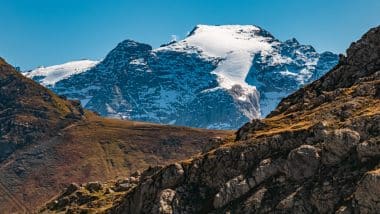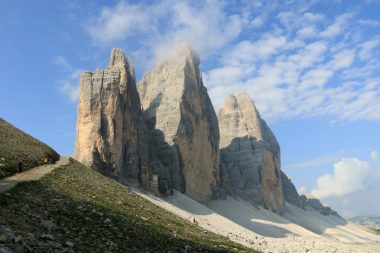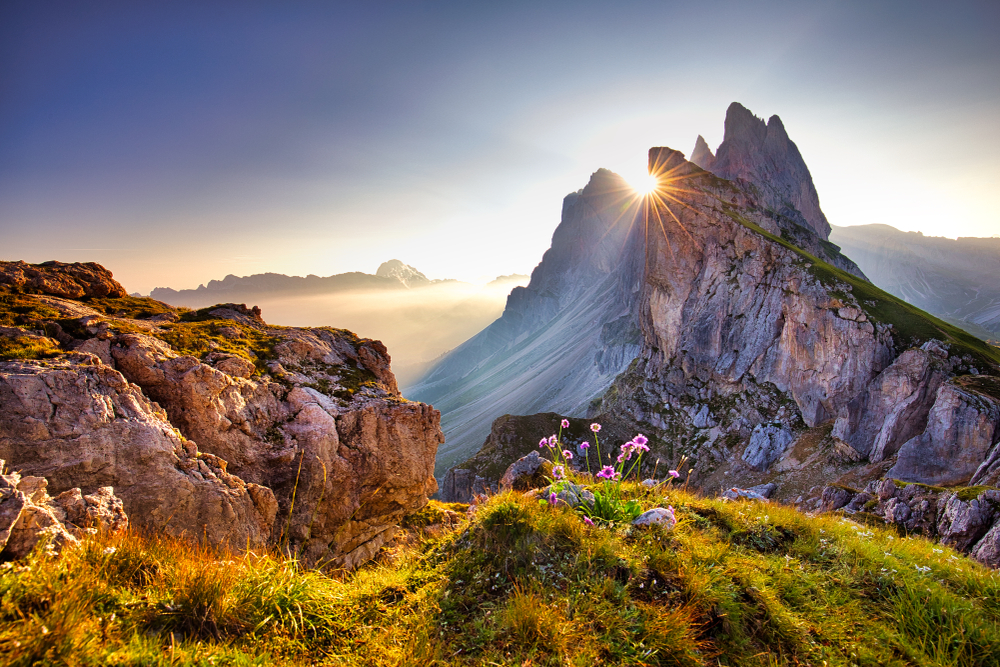Since 2009, parts of the Dolomites have been a UNESCO World Heritage Site. Formed more than 200 million years ago, the spectacular rock formations of gentle mountain meadows, alpine pastures and steeply rising rocks made of dolomite and limestone in between are a true holiday paradise for mountaineers, hikers and winter sports enthusiasts alike. This unique bizarre mountain landscape stretches over four Italian provinces from South Tyrol via Trentino (Trento), Belluno, Udine to Pordenone in the Friuli-Venezia Giulia region in northeastern Italy. The highest mountain in the Dolomites is the Marmolada at 3,342 m a.s.l. in the mountain range of the same name. It is also home to the only larger glacier still in existence, the Marmola Glacier. The second highest mountain in the Dolomites is the Antelao in the Ampezzo Dolomites at 3,264 m a.s.l. The most striking and yet most famous mountain massif are without a doubt the Three Peaks in the Sesto Dolomites. There are other magnificent mountain massifs in the region, such as the 2,563 m high Sciliar, the landmark of South Tyrol, the Sella Group, the Catinaccio and the Odle Group, named after the Geisler peaks, as well as the Sassolungo in the Sassolungo massif.
A little history of the Dolomites!
At the beginning of the 18th century, the mountains of the Dolomites were still called “pale mountains”. It was not until the end of the 18th century that they received their current name in honour of the French geologist Déodat de Dolomieu (1750–1801). He had analysed the chemical composition of dolomite, the predominant type of rock in the Dolomites, for the first time. The border between Germany , Austria and Italy ran through the Dolomites as early as the Middle Ages. During the First World War, the border was also a war front. Even today, you can find many traces of the war here, such as the war tunnels on the small Lagazuoi.
Recommended excursion destinations and sights in the Dolomites!
There are numerous attractions, natural wonders and magical places in the Dolomites that holidaymakers should definitely visit. The most impressive among them are:
The Marmolada

The Höhlenstein Valley
The approximately 15-kilometre-long wildly romantic valley with its untouched natural landscape and impressive mountains will not let go of hikers, bikers and mountaineers alike. The mountain lakes Dürrensee and Toblacher See in the valley are an attraction in their own right. From the shore of the turquoise-green Dürrensee, the view extends to the mountains of the Ampezzo Dolomites. Nearby is also the “Three Peaks View” with a view of the Three Peaks. Lake Dobbiaco also has a lot to offer. A small boat trip on the mountain lake lake should not be missed by romantics.
Cortina d’Ampezzo
The popular winter sports resort, located in the middle of the famous 3000 m peaks in the Dolomites, not only has something to offer skiers. The pedestrian zone with Italian flair, numerous shops, typical restaurants and inns invites you to stroll and linger.
The Messner Mountain Museum Corones
In the museum, which is located on the 2,275-metre-high Kronplatz summit, you can see climbing equipment and Messner’s personal belongings as well as numerous paintings and photographs. Furthermore, there is the possibility to watch some films with Reinold Messner in a small screening room. But the building itself is also worth a visit. Much of the museum is located underground in the mountain. On the outside are only the entrance area, two large viewing windows and another viewing window with a viewing balcony. From here, the visitor has a gigantic view of the wonderful mountain world, which not only Reinhold Messner loves so much.
The Three Peaks

San Candido
The romantic town in Alta Pusteria has a charming city centre with a pedestrian zone and numerous shopping facilities. The collegiate church with its three-aisled basilica, three apses and a crossing dome typical of the Romanesque period is particularly worth a visit. Right next to it is the parish church of St. Peter. Michael, which is also worth seeing. In the DoloMythos Museum, located in the pedestrian zone, interested guests can learn interesting facts about the Dolomites.
Two suggestions for active holidaymakers
The Val Gardena
Active holidaymakers get their money’s worth here at any time of the year. Skiing in winter, hiking and biking in summer. From the well-known towns of Ortisei, S. Cristina and Selva you can explore the world of the Dolomites. Once on foot, by bike or alternatively by cable car up to the Alpe di Siusi or the Seceda Alm will certainly be unforgettable.
The Alpe di Siusi
Europe’s largest high alpine pasture scores in winter with numerous ski slopes, well-groomed cross-country ski trails and toboggan runs and in summer with well-developed hiking trails and mountain bike tours. Just as varied as the sporting activities are the numerous places to stop for refreshments to quench hunger and thirst. The many alpine huts around the Alpe di Siusi offer plenty of culinary delights. From a rustic snack to a gourmet meal, the mostly family-run businesses spoil their guests with traditional dishes made from local and regional products. The huts are easy to reach, either on foot, by cable car, by carriage or by mountain bike.


